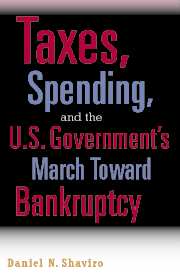Book contents
- Frontmatter
- Contents
- Acknowledgments
- Part 1 Labels and Consequences: The Failure of Our Fiscal Language
- 1 Fiscal Language and the Fiscal Crisis
- 2 Taxes, Spending, and the Size of Government
- 3 Fun and Games with Budget Deficits
- Part 2 The Why and How of Long-Term Budgeting
- Part 3 Labels and Policies across Budget Categories
- Part 4 Conclusion
- Notes
- Bibliography
- Index
3 - Fun and Games with Budget Deficits
Published online by Cambridge University Press: 18 December 2009
- Frontmatter
- Contents
- Acknowledgments
- Part 1 Labels and Consequences: The Failure of Our Fiscal Language
- 1 Fiscal Language and the Fiscal Crisis
- 2 Taxes, Spending, and the Size of Government
- 3 Fun and Games with Budget Deficits
- Part 2 The Why and How of Long-Term Budgeting
- Part 3 Labels and Policies across Budget Categories
- Part 4 Conclusion
- Notes
- Bibliography
- Index
Summary
Child: We're going to be late!
Navy SEAL played by Vin Diesel: Not on my watch.
– From The Pacifier (2005 movie and trailer)“The question is,” said Alice, “whether you can make words mean so many different things.” “The question is,” said Humpty Dumpty, “which is to be master – that's all.”
– Lewis Carroll, Through the Looking Glass“Deficits don't matter,” Vice President Cheney once remarked (Suskind 2004, 291). They are a “threat,” warned Alan Greenspan. In stating these very different views, one thing the two men probably had in common was confidence that the term “deficit” offers a meaningful measure of something.
Just what the deficit measures, and how well, is considerably less clear. As we will see more fully in Part Two of this book, the deficit is thought relevant to a number of different concerns, ranging from generational equity to easing recessions to the danger of default. As a multipurpose tool, however, it should immediately be suspect. At least a Swiss Army knife has separate attachments for each of its separate functions. The deficit, by contrast, apparently is meant to serve all of its multiple purposes at once.
To measure the deficit in its simplest form, you compare the government's cash inflows to its cash outlays for the year, disregarding any cash flows that are classified as involving debt principal. An excess of outlays is a deficit, while an excess of inflows is a budget surplus.
- Type
- Chapter
- Information
- Publisher: Cambridge University PressPrint publication year: 2006
- 1
- Cited by



